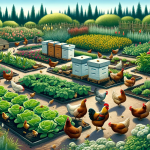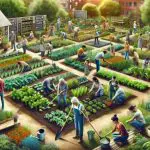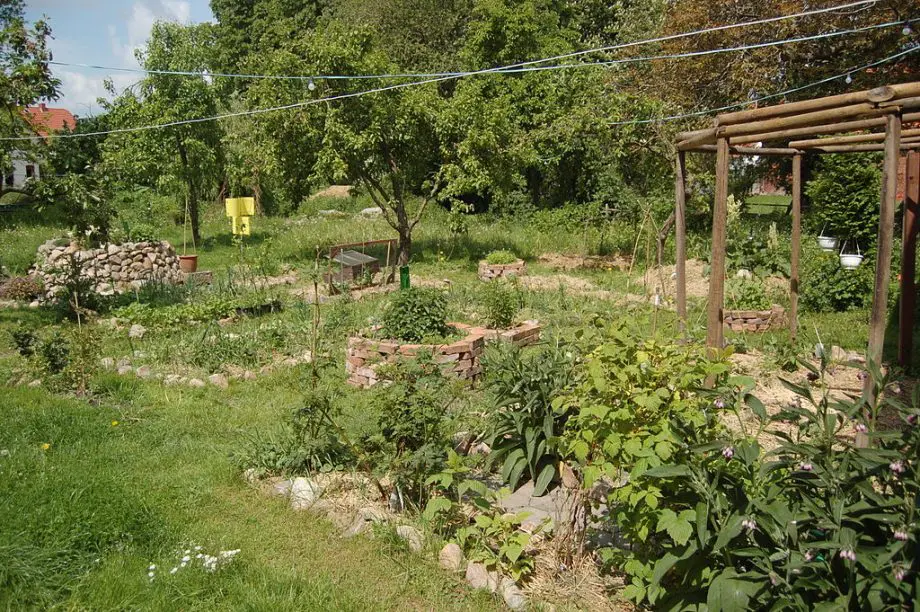
Explore the world of permaculture farming, a sustainable approach to agriculture that harmonizes with nature for a healthier planet. Dive into its principles and benefits!
Permaculture Farming Key Takeaways:
- Permaculture farming is an eco-friendly approach to agriculture, integrating crops and livestock with natural processes to create self-sustaining ecosystems.
- It emphasizes biodiversity, resource conservation, and sustainable living practices, aiming for environmental and agricultural harmony.
Have you ever wondered about permaculture farming and how it’s changing the face of sustainable agriculture?
It’s an approach that’s not just about growing crops, but about nurturing a thriving ecosystem.
Join us as we delve into the fascinating world of permaculture farming, where every plant and animal plays a pivotal role in a greater ecological symphony.
Understanding Permaculture Farming
Permaculture farming, a term often whispered among environmentally conscious individuals, is more than just an agricultural practice; it’s a philosophy for sustainable living.
But what exactly is permaculture farming?
At its core, it’s an approach that harmonizes human activities with the natural environment, creating systems that are ecologically sound and economically viable.
This article dives into the intricacies of permaculture farming, exploring its principles, benefits, designs, and practices.
Whether you’re a seasoned farmer or a curious novice, understanding the essence of a permaculture farm can be a gateway to more sustainable living.
Holistic Approach to Permaculture Farming
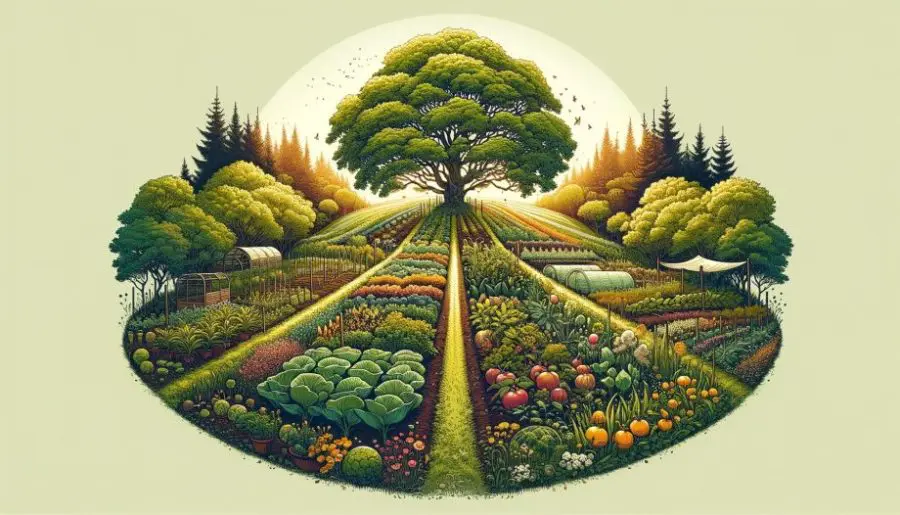
Embarking on the journey of permaculture farming means embracing a holistic approach that transcends traditional agriculture.
It’s a philosophy that intertwines the growth of crops and the raising of livestock with the rhythms of the natural world.
In this section, we delve into the essence of what permaculture farming truly entails: a symbiotic relationship with nature, fostering a sustainable and productive environment.
We’ll explore how this approach harmoniously blends various elements of the ecosystem, illustrating how permaculture is not just about farming, but about cultivating a deeper, more meaningful connection with the earth.
What is Permaculture Farming?
At the heart of permaculture farming is a commitment to developing agricultural ecosystems intended to be sustainable and self-sufficient.
Unlike traditional farming methods, which often rely heavily on artificial inputs and can degrade the environment over time, permaculture farming adopts a more holistic view.
It seeks to work in harmony with natural systems, creating a balance that benefits both the land and the farmer.
- Integration with Nature: Permaculture farming integrates crops and livestock with the natural elements of the landscape, using natural resources like rainwater and solar energy efficiently.
- Sustainable Techniques: This approach emphasizes sustainable techniques like composting, natural pest control, and maximizing biodiversity, which enhances the resilience and productivity of the farm.
- Community Impact: Permaculture extends beyond the farm, often creating a positive impact on the local community by promoting sustainable practices and fostering a connection with nature.
The Essence of a Permaculture Farm

A permaculture farm is not just a piece of land where crops grow; it’s an ecosystem in itself.
It’s designed to mimic natural processes and cycles, reducing waste, conserving resources, and creating a self-sustaining environment.
The design of a permaculture farm is thoughtful and deliberate, taking into account the local climate, soil type, and water availability to create a harmonious blend of elements that work together.
- Design Principles: Permaculture farms are designed based on specific principles like observing and interacting with nature, catching and storing energy, and obtaining a yield.
- Diversity and Polyculture: These farms typically feature a diverse range of plants and animals, as opposed to the monoculture approach of conventional farming. This diversity helps to create a balanced ecosystem and reduces the need for chemical inputs.
- Adaptability and Resilience: Permaculture farms are adaptable to changes in the environment, making them resilient against climate change and other ecological challenges.
Core Tenets and Principles of Permaculture Design
Permaculture design is not just a set of agricultural techniques; it’s a philosophy embedded with core tenets and principles that guide its practice. Understanding these tenets is crucial to grasping what permaculture farming truly entails.
Three Core Tenets:
The foundation of permaculture lies in its three core tenets – care for the earth, care for the people, and fair share.
This ethical framework guides all permaculture practices, ensuring that they contribute positively to the environment and society.
The 12 Design Principles:
Originating from the innovative minds of David Holmgren and Bill Mollison, the 12 principles of permaculture design range from ‘observe and interact’ to ‘creatively use and respond to change.’ Each principle acts as a compass, guiding the permaculture farmer in creating systems that are both sustainable and efficient.
Holmgren’s Influence:
Holmgren’s principles have shaped permaculture design significantly, encouraging farmers to think beyond traditional farming boundaries and integrate ecological and environmental considerations into their practices.
Permaculture (from “permanent agriculture”)is an integrated system of ecological and environmental design which Mollison co-developed with David Holmgren, and which they together envisioned as a perennial and sustainable form of agriculture. In 1974, Mollison began his collaboration with Holmgren, and in 1978 they published their book Permaculture One, which introduced this design system to the general public. Mollison is also the developer of the herb spiral, a herb growing structure that allows herbs with different growing requirements to coexist in a small space. From Wikipedia
Advantages and Disadvantages of Permaculture Farming

While permaculture farming has numerous advantages, it’s essential to acknowledge its challenges.
Advantages:
- Sustainability and Resilience: Permaculture farms are designed to be sustainable and resilient, providing long-term benefits to the environment.
- Reduced Dependence on External Inputs: By mimicking natural ecosystems, permaculture reduces the need for external inputs like chemical fertilizers and pesticides, leading to a healthier environment.
- Biodiversity: Permaculture promotes biodiversity, which is crucial for ecological balance and the health of the farm.
Disadvantages:
- Initial Time and Effort: Setting up a permaculture system can require significant initial time and effort compared to traditional farming methods.
- Learning Curve: The principles of permaculture can be complex and require a deep understanding and adaptation to local environments, which might be challenging for beginners.
- Scale Limitations: While permaculture practices can be applied on various scales, they may not always be feasible for large-scale commercial farming due to their intensive nature.
Permaculture Garden: A Microcosm of Sustainable Agriculture

Permaculture gardens are a testament to the versatility and adaptability of permaculture principles.
They are not merely spaces for growing food; they are vibrant, diverse ecosystems that embody the essence of sustainable agriculture.
Design and Layout:
The design of a permaculture garden is crucial. It involves careful planning and consideration of factors like sunlight, wind, and water sources.
The layout often includes raised beds, companion planting, and integrated pest management strategies.
Diversity and Polyculture:
Unlike conventional gardens, permaculture gardens thrive on diversity.
They often feature a mix of vegetable beds, fruit trees, herbs, and beneficial flowers, creating a polyculture that supports a healthy ecosystem.
Benefits for the Environment and Community:
Permaculture gardens provide numerous environmental benefits, such as enhancing soil fertility, conserving water, and promoting biodiversity.
They also serve as educational spaces for communities, promoting sustainable living practices.
Benefits of Permaculture Farming
The benefits of permaculture farming are manifold, reflecting its holistic approach to agriculture.
- Environmental Stewardship: Permaculture farming practices foster environmental stewardship, emphasizing soil health, water conservation, and biodiversity.
- Economic Viability: By reducing reliance on purchased inputs and promoting self-sufficiency, permaculture can be economically viable for farmers.
- Community Engagement: Permaculture often involves community engagement and education, spreading awareness about sustainable practices and fostering local food systems.
Permaculture Farming Design: Creating Synergy with Nature
Permaculture farming design is a creative and scientific approach, meticulously crafted to create synergy with nature.
It’s about seeing the farm as a cohesive ecosystem, where every element has a purpose and works in harmony with others.
Observation and Adaptation:
The first step in permaculture design is observation. Understanding the natural processes, climate patterns, and land topography guides the creation of a farm that adapts to and benefits from its natural surroundings.
Energy Efficiency and Sustainability:
Permaculture designs focus on maximizing energy efficiency and sustainability.
This involves using renewable resources, designing for energy conservation, and creating closed-loop systems that recycle waste.
Specific Techniques:
Techniques like companion planting, rainwater harvesting, and utilizing natural pest control play a significant role in permaculture design, each contributing to a sustainable and efficient farming system.
Permaculture Farming Definition and Examples
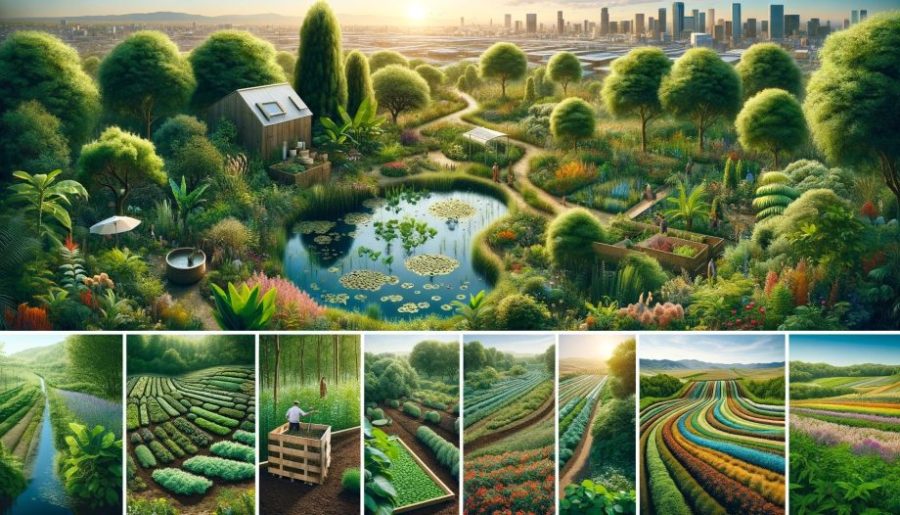 To define permaculture farming is to describe a system that mimics the resilience and diversity of natural ecosystems.
To define permaculture farming is to describe a system that mimics the resilience and diversity of natural ecosystems.
It’s about creating a farm that is more than just a place for food production; it’s a habitat for diverse species, a reservoir of water and nutrients, and a sustainable source of livelihood.
Examples:
- Urban Permaculture Gardens: These are excellent examples of how permaculture principles can be adapted to small spaces, creating sustainable and productive gardens in urban settings.
- Rural Permaculture Farms: These larger-scale operations demonstrate how permaculture can sustainably manage land, conserve natural resources, and produce a variety of crops and livestock.
The Impact of Permaculture Farming in India and Beyond
Permaculture farming in India represents a significant shift towards sustainable and eco-friendly agricultural practices.
In a country facing challenges like soil erosion, water scarcity, and declining farm productivity, permaculture offers a ray of hope.
- Adaptation to Local Conditions: Permaculture in India adapts to local climatic conditions and cultural practices, proving its versatility and applicability in diverse environments.
- Success Stories and Case Studies: There are numerous success stories where permaculture has transformed barren lands into lush, productive farms in India, showcasing the potential of these practices in improving livelihoods and ecosystems.
- Global Influence: The success of permaculture in India has inspired similar movements worldwide, demonstrating that sustainable farming is not just a local solution but a global necessity.
Permaculture Farming Courses: Spreading Knowledge and Skills
The growing interest in permaculture has led to the proliferation of permaculture farming courses worldwide.
These courses offer comprehensive training in permaculture principles, design, and practices, empowering individuals to start their own permaculture projects or enhance existing ones.
Benefits of Courses:
- Skill Development: These courses provide hands-on experience and knowledge, essential for successfully implementing permaculture practices.
- Networking and Community Building: They offer opportunities to connect with like-minded individuals and build a community of permaculture practitioners.
FAQs About Permaculture Farming
Curious about how permaculture farming can transform conventional agriculture? You’re not alone!
In this section, we’ll explore some of the most frequently asked questions about permaculture farming.
From its basic definition to its practical applications, benefits, and challenges, we aim to shed light on this innovative approach to sustainable agriculture.
Whether you’re a seasoned gardener or just beginning to dip your toes into the world of eco-friendly farming, these FAQs will provide valuable insights into the permaculture journey.
Q: What is permaculture farming?
A: Permaculture farming is a sustainable approach to agriculture that integrates human activities with natural processes to create self-sufficient ecosystems.
It emphasizes environmental stewardship, biodiversity, and resource efficiency.
Q: What are the benefits of permaculture farming?
A: The benefits include improved soil health, water conservation, biodiversity, reduced reliance on artificial inputs, and enhanced ecological balance.
It’s also economically viable and fosters community engagement.
Q: Can permaculture be practiced in urban areas?
A: Absolutely. Urban permaculture gardens are becoming increasingly popular, demonstrating how permaculture principles can be adapted to smaller spaces and urban settings.
Q: Are there any disadvantages to permaculture farming
A: While permaculture farming has many advantages, challenges include the initial time and effort required for setup, the learning curve involved, and potential scale limitations for large-scale commercial farming.
Conclusion: Embracing the Future with Permaculture Farming
Permaculture farming is not just an agricultural method; it’s a sustainable way of living that respects and works with nature.
As we face global challenges like climate change and environmental degradation, permaculture offers a path to a more sustainable and resilient future.
By adopting permaculture principles, we can create productive, healthy ecosystems that benefit not only the environment but also our communities and economies.
The journey of permaculture farming is an ongoing one, filled with learning, adaptation, and growth, and it’s a journey well worth embarking on for the sake of our planet and future generations.
- A Solution for Modern Challenges: Permaculture farming presents a viable solution to contemporary environmental challenges. It addresses issues like soil degradation, water scarcity, and loss of biodiversity, making it an essential practice in our quest for environmental sustainability.
- Economic and Social Benefits: This farming method not only benefits the environment but also offers economic advantages through reduced reliance on costly inputs and enhanced food security. Socially, it fosters community engagement and connection, bringing people closer to the food they eat and the land they inhabit.
- Adaptability and Innovation: Permaculture is a dynamic and evolving practice. Its principles are adaptable to various climates and regions, making it a globally applicable approach. Continuous innovation and learning in permaculture practices ensure its relevance and effectiveness in changing environmental conditions.
- Education and Awareness: The spread of permaculture farming relies heavily on education and raising awareness. By educating more people about its principles and practices, we can create a ripple effect, leading to broader adoption and a significant positive impact on our planet.
- A Call to Action: The conclusion can serve as a call to action, encouraging readers to explore permaculture farming in their own lives, whether through starting a small garden, participating in community projects, or simply spreading the word about the benefits of this sustainable approach to living.


